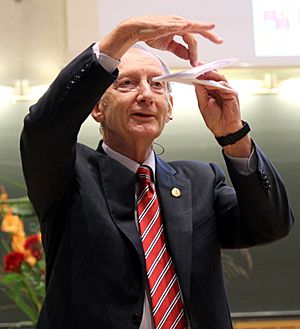John Pendry facts for kids
Quick facts for kids
John Brian Pendry
FRS HonFInstP
|
|
|---|---|

Pendry in 2014
|
|
| Born | 4 July 1943 |
| Nationality | British |
| Alma mater | Downing College, Cambridge |
| Known for |
|
| Awards |
|
| Scientific career | |
| Fields | Physics |
| Institutions |
|
| Thesis | The application of pseudopotentials to low energy electron diffraction (1970) |
| Doctoral advisor | Volker Heine |
Sir John Brian Pendry, born on July 4, 1943, is a famous British theoretical physicist. He is best known for his amazing work on metamaterials. His research helped create the first "Invisibility Cloak" and "Superlens". He is a professor at Imperial College London. There, he led the physics department for several years.
Contents
Who is Sir John Pendry?
Sir John Pendry is a scientist who studies how materials behave. He focuses on the theory behind how things work. He was born in Manchester, England. He has spent most of his career at Imperial College London. He is also an honorary member of Downing College, Cambridge. This is where he studied as a young man.
Early Life and Education
John Pendry went to Downing College, Cambridge. He earned a Master of Arts degree there. He also completed his PhD in 1969. His early research looked at how electrons move on surfaces. This was important for understanding materials.
A Career in Science
After finishing his studies, John Pendry became a research fellow. He worked at Bell Labs for a time. Then, he led a theory group at the Daresbury Laboratory. In 1981, he became a professor at Imperial College London. He has written over 300 research papers. He has also encouraged many new experiments.
He was made a Fellow of the Royal Society in 1984. This is a very high honor for scientists. In 2004, he was given the title of "Sir." This means he was knighted for his contributions.
Amazing Discoveries in Physics
Sir John Pendry has made many important discoveries. His work has changed how we think about light and materials. He has explored how to create materials with new properties.
What are Metamaterials?
Metamaterials are special materials. They are designed by scientists. These materials have properties not found in nature. They can control light, sound, or other waves. This is done by shaping them in very tiny ways. Pendry's ideas helped create the field of metamaterials.
The Perfect Lens
In 2000, Pendry wrote about a "perfect lens." This lens could focus light in an amazing way. It could show details much smaller than regular lenses. This idea was first thought to be impossible. But experiments later proved his theory. The idea of the superlens has changed how we see tiny things.
The Invisibility Cloak
One of his most famous ideas is the "invisibility cloak." In 2006, he suggested a way to bend light. This would make an object inside the cloak seem to disappear. It works by guiding light around the object. This makes it look like nothing is there. Scientists have shown this idea works with microwaves. This exciting research has inspired many new studies.
Understanding Electron Behavior
Before metamaterials, Pendry studied electrons. He looked at how electrons behave on surfaces. This helped scientists understand materials better. His methods made it easier to study surfaces. This early work laid the groundwork for his later discoveries.
Awards and Honors
Sir John Pendry has received many awards. These awards recognize his important contributions to science.
- In 2024, he won the Kyoto Prize in Advanced Technology. This is a major international award.
- In 2019, he received the SPIE Mozi Award. This was for his work on the perfect lens.
- In 2016, he was awarded the Dan David Prize.
- In 2014, he shared the Kavli Prize in Nanoscience. This was for his work on nano-optics.
- In 2013, he won the Institute of Physics Isaac Newton Medal.
- He also received the IOP Dirac Prize in 1996.

